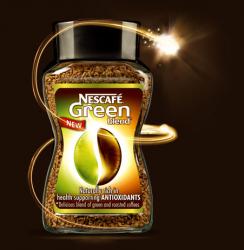 I have to admit I don’t normally drink instant coffee. It reminds me of being a student and, when visiting someone’s room, the obligation to drink a cup of the horrid stuff, normally garnished with semi-curdled milk from a carrier bag hung out the window for days. It was the social lubricant of my time and the cause of many a late night on the loo.
I have to admit I don’t normally drink instant coffee. It reminds me of being a student and, when visiting someone’s room, the obligation to drink a cup of the horrid stuff, normally garnished with semi-curdled milk from a carrier bag hung out the window for days. It was the social lubricant of my time and the cause of many a late night on the loo.
So invited to meet Nescafe Master Taster Dave Roberts I pack all my prejudices into a neat, easily hurled bundle and march round the corner to Liberty’s where he is conducting a taste class. Displaying my deep knowledge of coffee and the hard line of questioning that has made chefs tremble I ask him the big one. ‘What’s instant coffee made out of then, eh?’
‘Coffee,’ he replies smoothly. ‘We make essentially a giant cafetiere of coffee, just as you would at home, using freshly roasted and ground beans and then we take the water out.’ This process, dehydration, results in a powder, or more popularly today granules, and was a process invented by a Japanese scientist in 1901. Nescafe began their own version in 1938.
 The popularity of instant coffee, not just amongst students, is staggering. In the UK alone we spend over £600m on 13 billion cups of instant every year. This despite the fact that it seems every second high street shop is a Starbucks or a Prêt selling the poncey ‘proper’ stuff. Nescafe is probably the biggest brand out there, although those of us of a certain age fondly remember Red Mountain and can still, if not forcibly prevented, sing the jingle all the way through.
The popularity of instant coffee, not just amongst students, is staggering. In the UK alone we spend over £600m on 13 billion cups of instant every year. This despite the fact that it seems every second high street shop is a Starbucks or a Prêt selling the poncey ‘proper’ stuff. Nescafe is probably the biggest brand out there, although those of us of a certain age fondly remember Red Mountain and can still, if not forcibly prevented, sing the jingle all the way through.
Nescafe take a lot of care over their coffee, probably more than the gap-year New Zealander who is not paying attention as he serves you in Prêt. Please don’t make me repeat my order a third time you antipodean oaf! Coffee grows around the world between the tropics of Cancer and Capricorn and is an evergreen shrub. Two beans form within every red ‘cherry’ fruit and Nescafe use Arabica and Robusta both selected by the farmer at their ideal ripeness.
David invites me to try Gold Blend, surely the best known instant coffee in the UK. This has a high Arabica bean content, not too intense and with floral notes. We also try Alta Rica, one of Nescafe’s premier coffees and 100% Arabica bean. It’s bitter in a good way, perfect for after dinner and grown ups. You know actually it’s not bad at all, instant coffee has come a long way and Nescafe’s new Green Blend actually contains unroasted green beans to boost coffees already high levels of polyphenol antioxidants.
 ‘Can you taste the difference between fresh brewed ground coffee and instant?’ I ask Dave, alert for any signs of hesitation. Dave and another David at Nescafe, David Baxter, have probably tasted more than 9m cups of coffee in their professional careers – often up to 750 cups before lunch, so he is as expert as they get. ‘The difference between roast and ground and instant? It’s not worth the comparison,’ he says, rather fudging the issue, but he does add that once opened you should keep your instant coffee jar in the fridge for maximum flavour retention.
‘Can you taste the difference between fresh brewed ground coffee and instant?’ I ask Dave, alert for any signs of hesitation. Dave and another David at Nescafe, David Baxter, have probably tasted more than 9m cups of coffee in their professional careers – often up to 750 cups before lunch, so he is as expert as they get. ‘The difference between roast and ground and instant? It’s not worth the comparison,’ he says, rather fudging the issue, but he does add that once opened you should keep your instant coffee jar in the fridge for maximum flavour retention.
When it comes down to hot beverage of choice I’m still a tea person myself, but it’s been interesting to learn that Nescafe instant coffee isn’t made of anything other than 100% coffee beans and that there are plenty of blends to choose from. Maybe if there had been this much choice back in my student days I might have got better results. As blends go, the mix of unsupervised study and availability of beer wasn’t perhaps the best one when I think about it.
